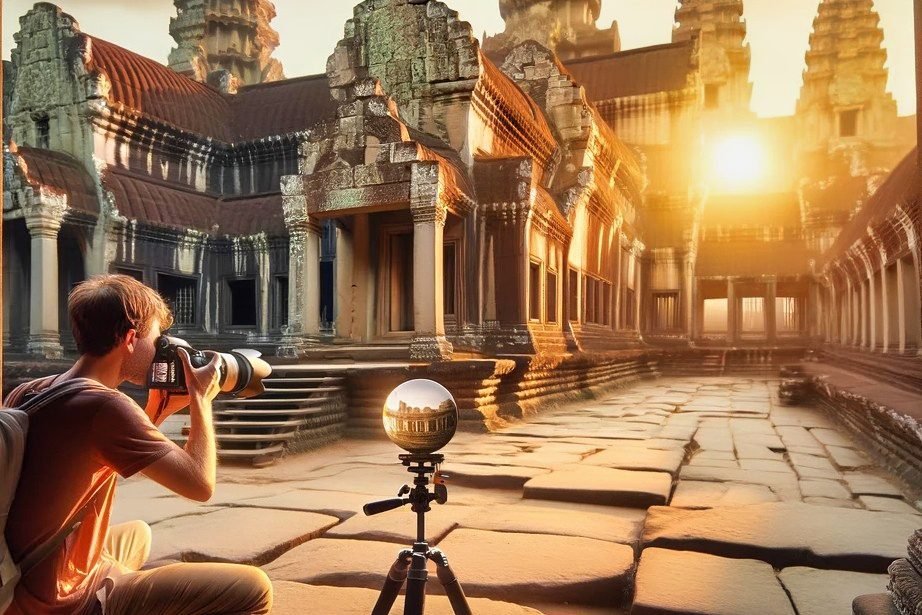Introduction: Capturing the Spirit with Advanced Photographic Techniques
Angkor, Cambodia’s archaeological marvel, offers endless opportunities for photographers. This guide explores the application of advanced photographic techniques to capture the essence of Angkor’s ancient beauty. To fully embrace this journey, photographers must not only possess technical skill but also an understanding of Angkor’s historical and cultural significance.
Mastering Light for Dramatic Imagery
The interplay of light at Angkor creates moments of unparalleled beauty. Early mornings or late afternoons, known as golden hours, bathe the temples in a soft, warm light, ideal for capturing their detailed carvings and grandeur. Overcast days, while often overlooked, provide a diffuse light that can evenly illuminate the complex’s intricate textures without the contrast of harsh shadows. Photographers should plan their shoots around these times, adjusting their schedules to be on-site during these optimal lighting conditions.
Night Photography: A Portal to Another Realm
When darkness envelops Angkor, a new, mystical world emerges. Utilizing long exposure techniques under the moon’s glow can reveal the haunting beauty of the temples at night. This requires not just technical knowledge of camera settings but also patience and creativity to capture the perfect shot. Night photography at Angkor is best undertaken on clear nights when the moonlight can serve as a natural source of illumination, transforming the ancient stones into a scene from a dream.
Golden Hour: The Magic of Transient Light
The golden hour’s ephemeral beauty demands quick action and preparedness. Photographers should scout locations beforehand, ensuring they know exactly where they want to be when the light is just right. This time of day is not just about capturing light but also about capturing a feeling, a moment when the world seems to stand still, and Angkor reveals its true majesty. Arriving early and having equipment ready can make the difference between a good photo and a breathtaking one.
Composition with Intention: Telling Angkor’s Story with Advanced Photographic Techniques
Creating compelling compositions at Angkor goes beyond simple framing. It involves understanding the narrative of each temple, its historical context, and its place within the larger complex. This means considering how each element in the frame — from the roots of a banyan tree embracing ancient stones to the serene faces of the Bayon — contributes to the story being told. Effective composition requires moving around, trying different perspectives, and even revisiting locations at different times of day to see how changing light alters the scene.
Exploring New Perspectives with Advanced Photographic Techniques: Beyond the Beaten Path
Angkor’s vast complex means that opportunities for unique photographs are nearly endless. Seeking out less-visited corners of the site or capturing well-known scenes from unconventional angles can reveal new stories. This exploration should be guided by curiosity and respect for the site, always mindful of preserving the integrity of Angkor’s heritage. Whether it’s finding a new angle on the iconic spires of Angkor Wat or capturing the daily life of those who maintain the temples, each photo can contribute to a deeper understanding of this historic site.
Innovative Gear Techniques: Enhancing Visual Narratives
Advanced Photographic Techniques means embracing innovative gear and techniques, such as lens balls that offer a spherical perspective or HDR imaging to balance extreme contrasts in light, can add depth to the visual narratives of Angkor. These tools allow photographers to experiment and find unique ways to convey the essence of the temples. However, mastering these techniques requires practice and an openness to trial and error, finding what works best in each situation to bring out the beauty of Angkor’s architecture and landscapes.
Adapting to the Elements: The Photographer’s Challenge
Angkor’s environment, marked by its seasonal changes, presents both challenges and opportunities. The lushness following the rainy season or the stark beauty of the dry season each offers a different view of the temples. Photographers must be adaptable, ready to capture the site’s beauty in all conditions, from the glistening wet stones after a rain to the soft mist of a foggy morning. Understanding how the elements affect light and mood is key to creating impactful images.
Conservation through Photography: A Respectful Approach
Photographing Angkor is a privilege that comes with responsibility. Images should not only seek to capture the site’s physical beauty but also to tell stories that respect and contribute to its preservation. Highlighting conservation efforts, portraying the temples with integrity, and fostering an emotional connection with viewers can all play a role in ensuring Angkor’s legacy endures.
Conclusion: Elevating Angkor’s Legacy Through the Lens
To truly capture Angkor’s essence, photographers must blend technical skill with a deep appreciation for its history and significance. By thoughtfully applying advanced photographic techniques and embracing visual storytelling, each image can become a tribute to Angkor’s enduring allure, inviting viewers to experience its majesty and mystery as if standing there themselves.
For those looking to deepen their photographic exploration of Angkor, personalized guidance from local experts like Tola can enrich the experience, offering insights into both the art of photography and the heart of Angkor.

